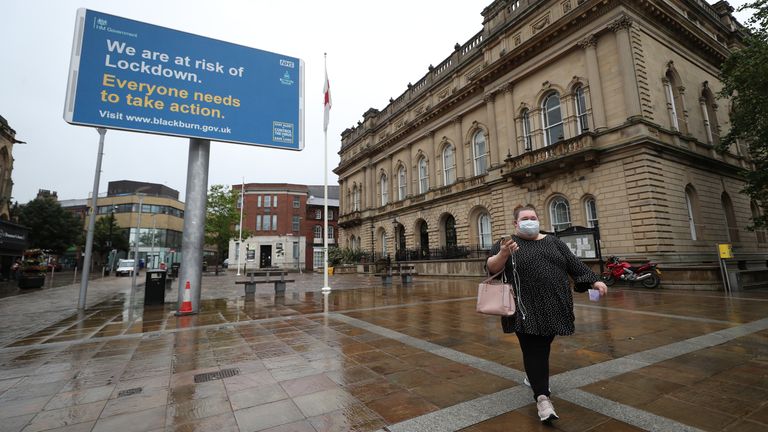There are now four councils in England classed as an “area of intervention” on the government’s coronavirus watchlist – but what does that mean?
What is the coronavirus watchlist?
The watchlist of local authorities is part of the weekly surveillance report of coronavirus infections published by Public Health England (PHE).
This is all part of Prime Minister Boris Johnson’s “whack-a-mole” strategy to deal with local flare-ups in COVID-19 infections.
The government hopes swift, targeted action in the worst-affected areas will reduce the spread of coronavirus and prevent the whole UK from having to enter a full lockdown.
The watchlist is based on the weekly rate of COVID-19 cases in local areas, as well as the trend of whether infections are rising or falling.
PHE says this data is also combined with a range of other indicators such as the test positivity rate, an assessment of the local response and plans, local healthcare and mortality.
The classification of a local council area on the watchlist is a “blended assessment drawing on professional judgement”, PHE says.
How is the watchlist categorised?
There are three categories into which local councils can be placed on the watchlist.
These are:
- areas of concern
- areas for enhanced support
- areas of intervention
What is an area of concern?
An area of concern is the lowest level on the watchlist.
It is described by PHE as one of those areas with the highest prevalence of COVID-19 but where local officials are taking targeted actions to reduce the number of infections.
For example, this could include additional testing in care homes or increased engagement with high-risk groups.
Areas of concern currently include Bradford, Calderdale, Kirklees, Northampton, Peterborough, Rochdale, Rotherham and Wakefield.
What is an area of enhanced support?
An area of enhanced support is the next level on the watchlist.
It is described by PHE as an area that is at medium or high risk of intervention and where there is a more detailed plan, agreed with national officials.
There will also be additional resources provided to support local officials, such as extra mobile testing or epidemiological experts.
Pendle, in Lancashire, is currently classified as an area of enhanced support.
What is an area of intervention?
An area of intervention is the highest level on the watchlist.
It is described by PHE as an area where there is a “divergence” between the local measures in place to control the spread of coronavirus and the national restrictions across England.
A detailed action plan will be in place and local resources will be boosted by national-level support.
Leicester, Oadby and Wigston, Blackburn and Darwen, and Luton are all currently areas of intervention.
Last month, Leicester and Oadby and Wigston were subject to the UK’s first full local lockdown.
In Blackburn and Darwen, and Luton, the local councils have responded to being named an area of intervention by delaying the opening of leisure facilities.
:: Listen to the Daily podcast on Apple Podcasts, Google Podcasts, Spotify, Spreaker
What can happen in an area of intervention?
Being classified an area of intervention does not necessarily mean that area enters a local lockdown, as occurred in Leicester and neighbouring Oadby and Wigston.
However, there are a range of measures that might be introduced in an area of intervention.
These include:
- closing certain businesses and venues such as shops, cafes, gyms, offices or warehouses
- cancelling events such as sports events, concerts or weddings
- closing outdoor public areas such as parks, playgrounds or beaches
- encouraging people to work from home
- closing schools or limiting schools to certain year groups
- restricting travel for everyone but key workers
- bespoke measures for those with underlying health conditions who are “shielding”
Government guidance also states that, in areas of intervention, national officials could take over decision-making.
This could be if:
- local leaders request such action
- if local resources aren’t sufficient
- if outbreaks impact on critical infrastructure or major parts of the economy or sectors such as food or energy production
- If local action has not been effective


